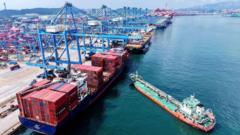As America commemorates the 50th anniversary of its withdrawal from Vietnam, the ramifications resonate deeply throughout Asia. While the scars of war linger, a new chapter unfolds as the region adjusts to a power dynamic increasingly tilted towards China.
The Shifting Dynamics of Asia 50 Years Post-Vietnam: The Rise of China

The Shifting Dynamics of Asia 50 Years Post-Vietnam: The Rise of China
The legacy of the Vietnam War continues to shape geopolitical landscapes as the U.S. retreats from influence in Asia, leaving a vacuum filled by China.
Fifty years ago, the last American troops left Vietnam, marking a retreat that forever altered America's role in Asia. This historic moment is not just a solemn reminder of loss for those who endured a brutal conflict; it is also a reflection of how countries in the region are now navigating their futures without the steadfast American presence of the past. The U.S. had once upheld a vision of a democratic Asia, bolstering its allies through economic aid and military support. Now, that model is shadowed by emerging realities, as Beijing exerts its influence more assertively.
Chinese presence is felt across Asia, particularly in strategic maritime areas like the South China Sea, where Beijing’s military expansion raises concerns among neighboring nations. Additionally, China's economic strategy is reshaping trade and infrastructure in places as far-flung as Nepal, where Chinese investment is flooding the market. This transformation highlights a paradigm shift that has left many countries grappling with an altered international order.
The emotional weight of this transition is palpable, evoking feelings ranging from nostalgia for American ideals to apprehension about the implications of China's dominance. Former adversaries are now engaging in a delicate balancing act, reflecting on a shared history while contending with competing interests in an evolving geopolitical landscape.
As the memories of Saigon linger, the importance of understanding the present dynamics in Asia becomes paramount for leaders and policymakers. The trend toward a diminished American influence in the region is not merely a backdrop; it is an unfolding scenario that invites scrutiny and thoughtful engagement.
Chinese presence is felt across Asia, particularly in strategic maritime areas like the South China Sea, where Beijing’s military expansion raises concerns among neighboring nations. Additionally, China's economic strategy is reshaping trade and infrastructure in places as far-flung as Nepal, where Chinese investment is flooding the market. This transformation highlights a paradigm shift that has left many countries grappling with an altered international order.
The emotional weight of this transition is palpable, evoking feelings ranging from nostalgia for American ideals to apprehension about the implications of China's dominance. Former adversaries are now engaging in a delicate balancing act, reflecting on a shared history while contending with competing interests in an evolving geopolitical landscape.
As the memories of Saigon linger, the importance of understanding the present dynamics in Asia becomes paramount for leaders and policymakers. The trend toward a diminished American influence in the region is not merely a backdrop; it is an unfolding scenario that invites scrutiny and thoughtful engagement.


















